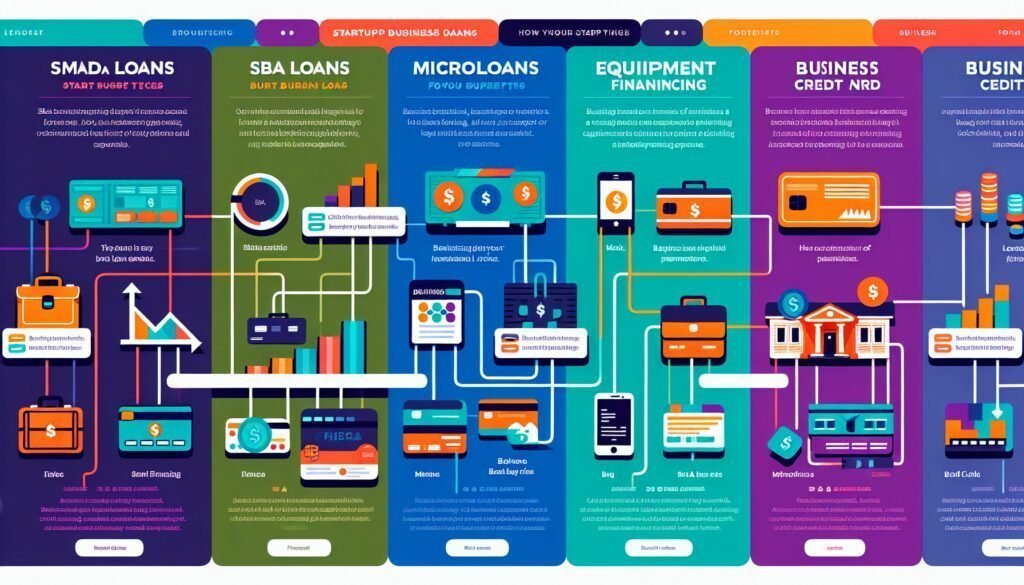Starting and scaling a tech business requires significant financial investment. Whether it’s for product development, hiring skilled talent, or expanding operations, securing the right funding is crucial. In 2025, various loan options are available for tech entrepreneurs, from traditional bank loans to AI-driven fintech solutions. This guide explores the best small business loans for tech startups, their benefits, and how to secure funding.
Why Tech Entrepreneurs Need Specialized Loans
The tech industry operates differently from traditional businesses, often requiring large upfront investments before generating revenue. Specialized business loans help tech startups with:
- Product Development – Funding for R&D and prototype creation.
- Scaling Operations – Hiring staff, expanding infrastructure, and acquiring technology.
- Marketing and Customer Acquisition – Promoting services and reaching a broader audience.
- Working Capital – Maintaining cash flow for day-to-day operations.
Types of Business Loans for Tech Startups
1. Traditional Bank Loans
- Best for: Established tech companies with strong financial records.
- Pros: Lower interest rates, large loan amounts.
- Cons: Strict eligibility criteria, longer approval times.
2. SBA Loans (Small Business Administration)
- Best for: Startups that meet SBA requirements.
- Pros: Low-interest rates, government-backed security.
- Cons: Extensive paperwork, long approval times.
3. Venture Debt
- Best for: Startups backed by venture capital.
- Pros: Helps extend cash runway without diluting equity.
- Cons: Requires strong financial backing from investors.
4. Online and Fintech Business Loans
- Best for: Startups seeking quick funding with flexible criteria.
- Pros: Fast approvals, AI-driven risk assessment.
- Cons: Higher interest rates compared to banks.
5. Equipment Financing
- Best for: Businesses needing hardware, software, or tech equipment.
- Pros: Helps finance costly tech tools without large upfront payments.
- Cons: Loan is tied to the purchased equipment.
6. Business Lines of Credit
- Best for: Tech startups needing flexible cash flow.
- Pros: Borrow as needed, pay interest only on what is used.
- Cons: Higher interest rates than traditional loans.
7. Revenue-Based Financing
- Best for: Startups with strong sales but limited collateral.
- Pros: Repayment is based on future revenue, reducing risk.
- Cons: Can be expensive in the long run.

Top Lenders for Small Tech Businesses in 2025
1. Traditional Banks
- Bank of America – Offers SBA loans and business term loans.
- Wells Fargo – Small business loans with competitive rates.
- Chase Bank – Business lines of credit and equipment financing.
2. Fintech Lenders
- Kabbage – AI-powered loan approvals.
- OnDeck – Fast business loans with minimal paperwork.
- Fundbox – Offers flexible lines of credit.
3. Alternative Lenders
- Lendio – A loan marketplace for comparing multiple lenders.
- BlueVine – Offers invoice factoring and business credit.
- Funding Circle – Peer-to-peer lending with fast approvals.
How to Qualify for a Tech Business Loan
1. Strong Business Plan
- Outline your product, target market, and revenue model.
- Include financial projections and growth strategies.
2. Good Credit Score
- A higher credit score increases loan approval chances.
- If the business lacks credit history, personal credit may be considered.
3. Stable Revenue and Cash Flow
- Lenders prefer businesses with consistent earnings.
- Revenue-based loans consider future earnings potential.
4. Collateral and Assets
- Some loans require collateral, such as equipment or intellectual property.
- SBA loans often require personal or business assets as security.
5. Business Experience and Industry Knowledge
- Lenders assess the entrepreneur’s experience in the tech sector.
- Previous successful ventures can improve approval odds.
Step-by-Step Process to Secure a Loan
Step 1: Assess Your Funding Needs
- Calculate how much capital is required.
- Identify the specific purpose of the loan.
Step 2: Research the Best Loan Options
- Compare interest rates, repayment terms, and eligibility criteria.
- Choose between traditional banks, fintech lenders, or government-backed loans.
Step 3: Prepare Necessary Documents
- Business financial statements.
- Tax returns and credit reports.
- Business plan and projected financials.
Step 4: Submit the Loan Application
- Apply online or in person, depending on the lender.
- Provide accurate and complete documentation.
Step 5: Loan Approval and Funding
- Traditional banks may take weeks, while fintech lenders offer same-day approvals.
- Once approved, funds are disbursed into your business account.
Tips to Increase Loan Approval Chances
- Improve Credit Score – Pay down debt and maintain good credit history.
- Demonstrate Business Growth – Show increasing revenue and market demand.
- Work with a Financial Advisor – Get expert guidance on funding options.
- Consider Alternative Lenders – If banks decline, fintech lenders offer flexible options.
The Future of Small Business Loans in Tech
1. AI-Driven Loan Approvals
- Automated risk assessments improve lending speed and accuracy.
- AI models analyze alternative financial data for credit decisions.
2. Blockchain-Based Lending
- Smart contracts enable instant, secure loan transactions.
- Decentralized finance (DeFi) platforms offer new funding avenues.
3. Increased Government Support for Startups
- More grant programs and low-interest loans for tech entrepreneurs.
- Expansion of SBA loan offerings tailored for tech businesses.
Conclusion
Securing the right loan is essential for tech entrepreneurs looking to scale their businesses. Whether choosing a traditional bank, a fintech lender, or alternative financing, understanding loan options and preparing a solid financial plan improves the chances of approval. As technology continues to evolve, AI-driven and blockchain-based lending will further shape business financing in 2025. By leveraging the best loan options, tech startups can achieve sustainable growth and innovation.
